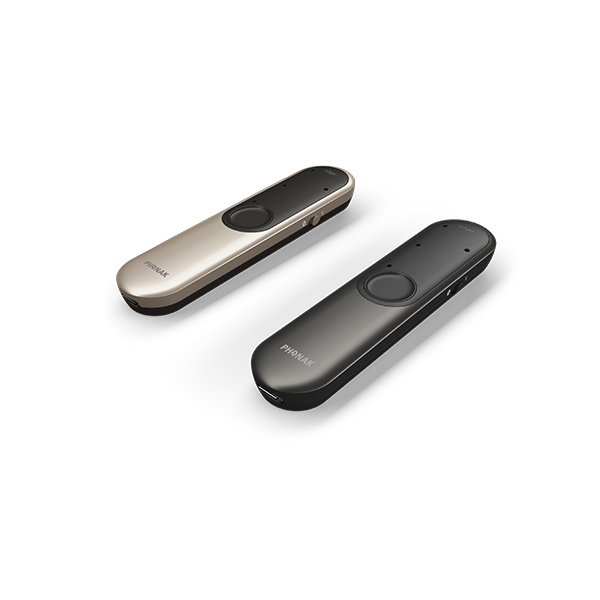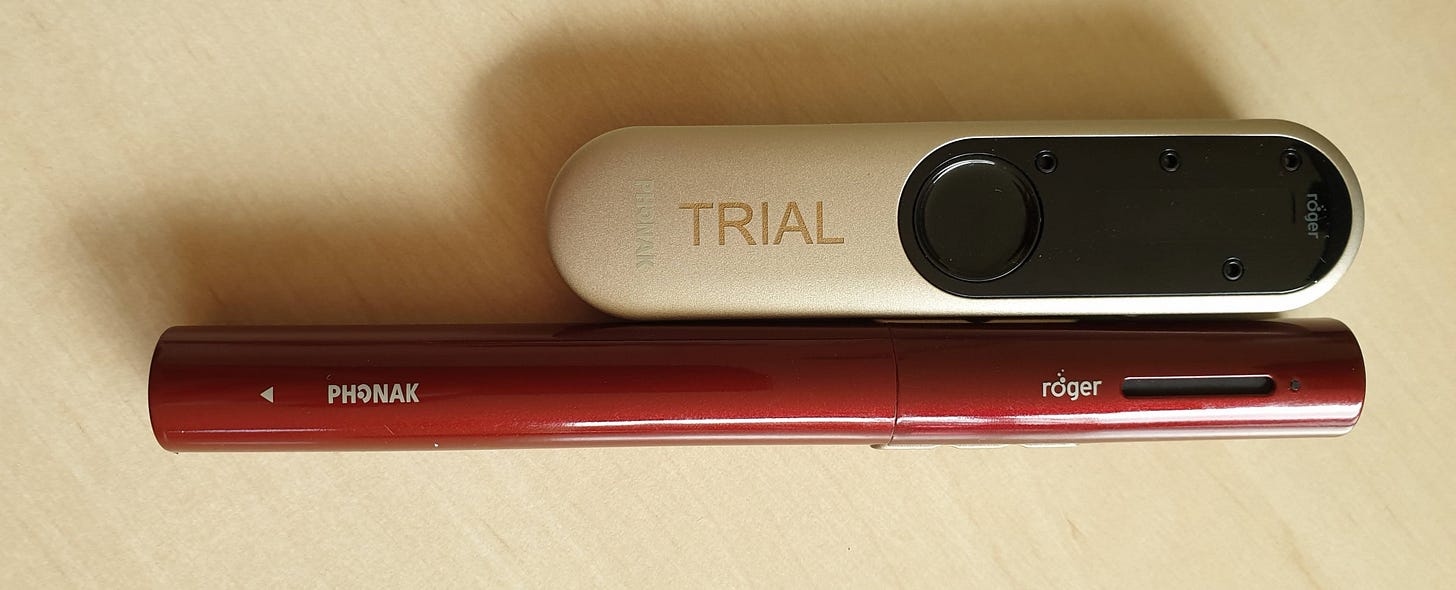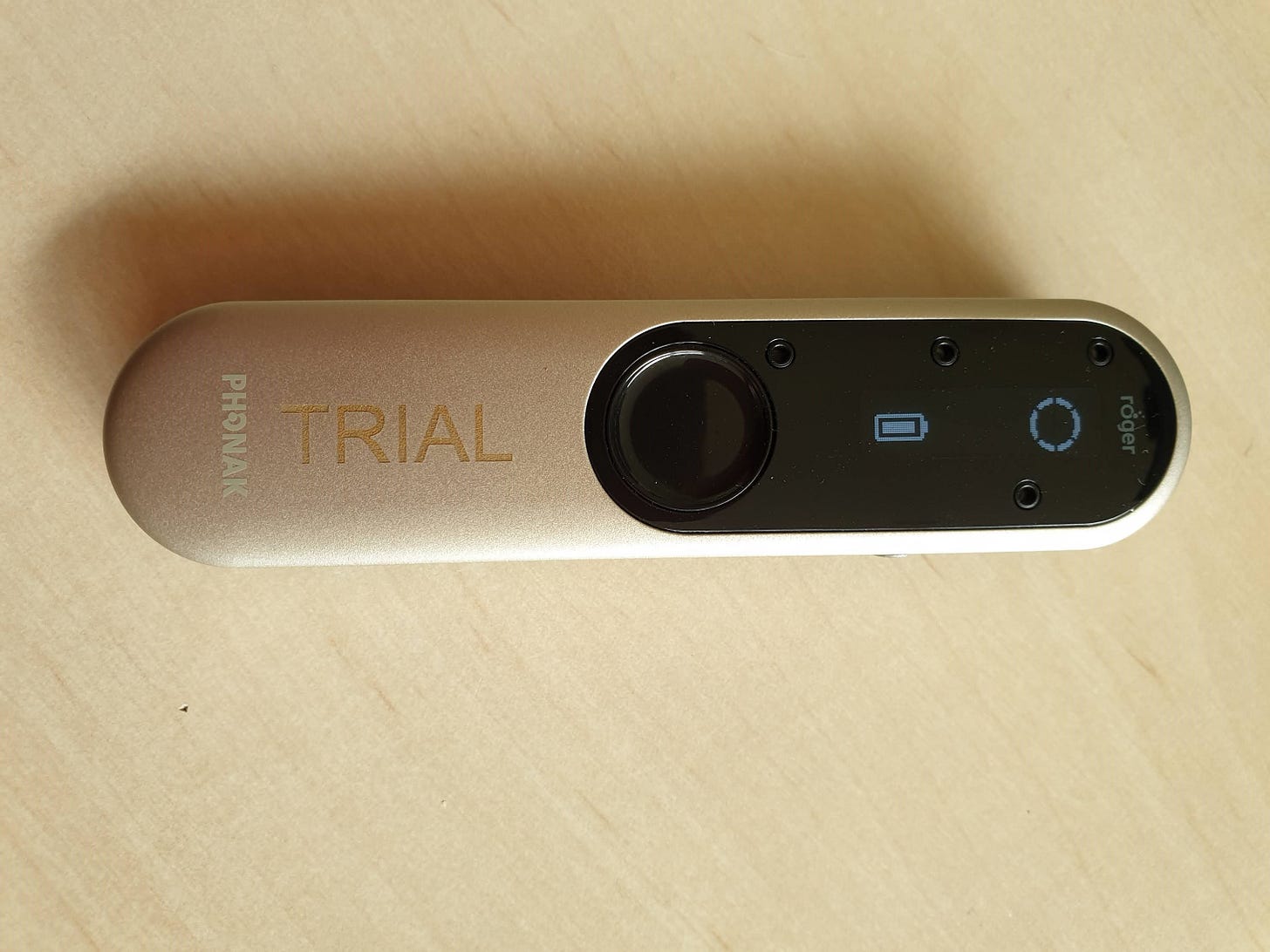According to the Hearing Health Foundation, 90% of tinnitus cases have an underlying hearing loss. When you’re trying to juggle both hearing loss and tinnitus it’s good to know what technology is out there to help you hear over these combined challenges.
The latest offering from Sonova is their Phonak Roger On. It combines the functionality of two of their existing products - the Roger Pen and the Roger Select in a very neat little product.
I’m especially excited to see the Roger On come to market as I was involved in discussion with the folks at Phonak about how to improve the Roger Pen, and what the next “version” of it could/should look like.
Who can use it
Most people who have hearing aids can use the Phonak Roger products. You may need a streamer or a receiver to create the connection – speak to your audiologist about this.
What it looks like
The Roger On is 4 inches (10cm) long, ½ inch (2cm) wide and ¼ inch (1cm) deep which makes it very neat and discreet held in the hand or laid on the table.
What it does
There are essentially seven things that you can do with the Roger On microphone:
Listen to a group of people using Table mode. Just pop the microphone in the centre of the table and enjoy being part of the conversation.
Listen to a single person, or a more focused group of people using Pointing mode. You don’t have to point it like a sonic screwdriver (unless you want to of course – don’t let me cramp your style!) but can instead hold it by your side as long as you point the microphone in the direction of the person you want to hear.
Listen to one person very clearly indeed using Presenter mode. You can use the clip to attach the Roger On to the speaker’s clothing, or the lanyard that is provided.
Stream audio from the TV direct to your hearing aid using the TOS link and docking station. This set-up splits the audio so others in the room can hear the TV as well as you. You can also choose to stream all the TV sound to your hearing aids if you want.
Stream audio from other devices directly into your hearing aids using the USBC to 3.5mm cable. Great for watching stuff on your laptop, tablet or phone, or listening to music or audiobooks while you’re doing boring, grown up stuff around the house.
Make phone calls from your mobile using the same cable.
Take landline phone calls (using some extra equipment and a bit of knowhow).
How it functions
The Roger On has a sliding on-off switch on the right hand side, and a USBC charging and data port on the bottom. The pairing button to connect the Roger On to your hearing aids, your FM receivers or other Roger devices, is tucked away on the back.
It has four microphones - three along the left side, and one on the right side - which allow the device to identify and select which direction to pick up sound from.
The biggest improvement for me is that the Roger On has a display screen that indicates which microphone mode you're in and how much battery life you have left. This is a huge improvement from the Roger Pen where you have to peer at a tiny flashing light to check its status.
As with the Pen, the Roger On selects which microphone to use depending on how the Pen is positioned. If you want to over-ride the automatic selection, the push button in the center of the microphone lets you manually select a microphone mode of your choice and lock that selection.
MyRogerMic - a dedicated app
For anyone with a smartphone, the Roger On also comes with a dedicated app. This is especially useful when the On is placed in the middle of the table when used in Table mode. The app can be used as a remote control so you don’t have to leave your seat to toggle between Table, Pointing and Presenter mode. You can also lock the Roger On in Table Mode, so if someone at the table moves the Roger On to put a dish of food down, you won’t lose your ability to hear everyone.
There’s also some really useful extra functionality in the app:
In Table mode you can select where you want it to pick up sound from. In this way it acts like the Roger Select. This is really helpful when you’re at a social event where the conversation is flowing, and you naturally want to chop and change who you’re speaking to.
You can create custom programs where you can save configurations of the microphones that you use often. Once you’ve saved these on the app they appear as an option on the Roger On display screen, as well as the app.
Pros:
A display screen enabling you to see at a glance the battery charge and microphone mode.
MyRogerMic, a dedicated app, which also acts as a handy remote control
Cons:
No Bluetooth for mobile phone calls! This is a biggie for me. I LOVE the Bluetooth on the Roger Pen and use it a lot. It feels too early in the roll-out of Bluetooth-enabled hearing aids to remove this function from the Roger On. For me, and many others without Bluetooth-enabled hearing aids, this stops the Roger On from being a complete assistive tech solution. I’m going to have to keep using the Pen, or a ComPilot to make mobile calls even if I use the Roger On for everything else. Which means the hassle of charging and carrying two pieces of kit .
Jury’s out:
I’ve been scratching my head trying to work out when I might use the custom modes on the app. I guess if there was somewhere I visited regularly where people sat in the same configuration each time it would be useful. But I’m struggling to think of an example!
Would I buy it?
If you have Bluetooth-enabled hearing aids, it’s a great device. But for me the lack of Bluetooth means I could not currently justify it as a complete replacement for my well-used Roger Pen.





